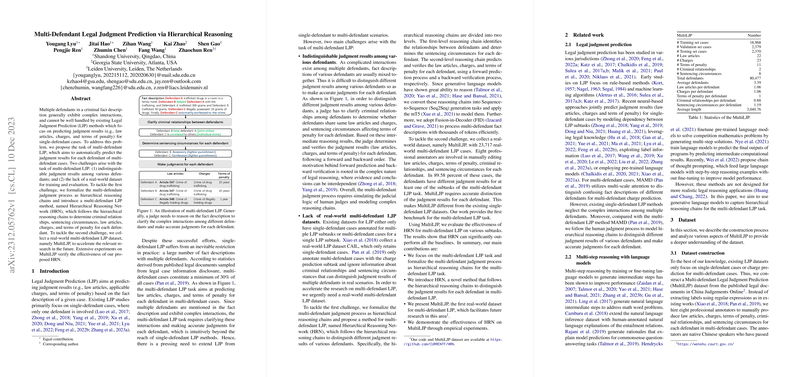Overview of Multi-Defendant Legal Judgment Prediction
The domain of Legal Judgment Prediction (LJP) has gained significant traction with the evolution of AI, and specifically, LLMs. Historically, LJP studies have predominantly been directed toward cases involving a single defendant. However, real-world scenarios often involve multiple defendants, raising the need for more sophisticated methods that can handle such complexities. Recognizing this gap, the research shifts the focus to multi-defendant LJP, posing a new set of challenges, including difficulty in discerning distinct judgment outcomes among various defendants due to their interwoven interactions and a dearth of real-world datasets to effectively train and evaluate models.
Hierarchical Reasoning Network (HRN)
To address the complex dynamics of multi-defendant cases, a new method called the Hierarchical Reasoning Network (HRN) is introduced. This method operates on hierarchical reasoning chains, simulating the logic that a judge might use to differentiate between defendants, determine their roles in the crime (i.e., principal or accessory), and understand the implications of their actions and confessions on sentencing. The HRN consists of a multi-step process that begins with establishing relationships amongst defendants and identifying sentencing circumstances, followed by law article determination and charge prediction, culminating in the decision of penalty terms.
The approach capitalizes on the generative capabilities of LLMs by translating hierarchical reasoning chains into Sequence-to-Sequence (Seq2Seq) generation tasks. This process involves a forward prediction mechanism to hypothesize the likely judgment results and a backward verification pattern to validate those judgments, introducing an iterative reasoning system akin to that of legal professionals.
Dataset Creation for Multi-Defendant Legal Judgment Prediction
Given the lack of multi-defendant LJP datasets, researchers compiled a substantial real-world dataset titled MultiLJP, featuring 23,717 real-world multi-defendant LJP cases. This dataset is curated through manual annotations from professional annotators who classify various aspects of the cases, such as law articles, charges, and terms of penalty, as well as discerning the relationships and circumstances for sentencing involved with each defendant.
This dataset is significant in its uniqueness, as it is the first to explicitly focus on multi-defendant legal situations. It is meticulously crafted, with a covered wide scope of defendants and requirements, thereby supplying a robust platform for future research within the sphere of multi-defendant LJP.
Effectiveness and Conclusion
Extensive evaluations conducted using the MultiLJP dataset indicate the robustness of the HRN method over traditional and baseline models, showcasing significantly better judgment predictions. Ablation studies reinforce the value of each component of the HRN, signifying that criminal relationships and sentencing circumstances significantly drive the model's ability to discern the judgments for different defendants. Furthermore, the forward prediction and backward verification processes solidify the accuracy of the eventual outcomes.
In conclusion, the move towards multi-defendant LJP through HRN marks a transformative step in legal AI, with the new dataset presenting extensive opportunities for academia and potentially revolutionizing the efficiency and consistency of the judicial process.
(Note: The paper, code, and the MultiLJP dataset are available online, offering resources for researchers aiming to develop or benchmark against this novel LJP framework.)
